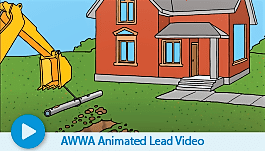Customer communications key to Revised Lead and Copper Rule
February 9, 2023

AWWA Articles
Customer communications key to Revised Lead and Copper Rule
 October 16, 2024 is coming.
October 16, 2024 is coming.
That is the date when all U.S. water utilities, whether they have lead service lines or not, must comply with certain requirements established by the U.S. Environmental Protection Agency (EPA) under its Revised Lead and Copper Rule (LCRR) to reduce exposure to lead and copper from water pipes and plumbing.
 The compliance deadline is Oct. 16, 2024. However, EPA anticipates making further revisions to the rule and plans to announce those changes prior to the compliance deadline.
The compliance deadline is Oct. 16, 2024. However, EPA anticipates making further revisions to the rule and plans to announce those changes prior to the compliance deadline.
“We highly recommend that all water systems act now to develop effective communication strategies to comply with the LCRR,” said Matthew Junker, chair of the Lead Communications Committee for the American Water Works Association’s (AWWA) Public Affairs Council.
“The rule includes many new requirements for water utilities of all sizes, including expanding consumer awareness, developing service line inventories, communicating about public health and testing at schools and child-care facilities,” he added. “This is a critical time for utilities to prepare to engage proactively with their customers and community to build public trust. The revised regulation requires some communications even if a system does not have lead service lines.”
 The Public Affairs Council developed a Lead Communications Guide and Toolkit to help water utilities prepare for the expanded communication requirements of the LCRR. The guide draws on insights and examples from utilities that have already begun to take such steps and provides a summary of LCRR requirements and guidance on approaching required communication and outreach. It also includes specific adaptations for water systems serving less than 50,000 customers.
The Public Affairs Council developed a Lead Communications Guide and Toolkit to help water utilities prepare for the expanded communication requirements of the LCRR. The guide draws on insights and examples from utilities that have already begun to take such steps and provides a summary of LCRR requirements and guidance on approaching required communication and outreach. It also includes specific adaptations for water systems serving less than 50,000 customers.
Other AWWA resources about managing lead and lead communications are available for download, including an animated video that helps consumers understand how to protect their households from the risk of lead getting into their drinking water through service lines or plumbing fixtures, fittings and solder that contain lead.
Even water systems that can demonstrate that they do not have lead service lines must comply with specific requirements of the LCRR by Oct. 16, 2024, including the bulleted items below. Notably, there are requirements for utilities with galvanized service lines that are or could have been downstream of a lead service line, or that have “lead status unknown” service lines.
- Publish a lead service line inventory or a statement of no lead service lines. Every water system must provide a publicly accessible inventory. This should include a description of how the system determined if, how many, and where there are lead, galvanized requiring replacement, non-lead, and lead status unknown service lines in its service area. Systems that can demonstrate there are no lead, lead status unknown, or galvanized requiring replacement lines must still release a statement and explain its basis.
- Communicate with customers that participate in LCR compliance monitoring. The LCRR sets higher expectations for assurance that sample sites are valid and includes a new sampling protocol. It also requires notice of results over the lead action level within three calendar days and a follow-up investigation of observations above the lead action level. Utilities will need to revise protocols, supporting materials and outreach procedures to support customer participation in compliance monitoring.
- Prepare for Tier 1 public notice if a system exceeds the lead action level. Tier 1 public notification must occur within 24 hours of recognition of a lead exceedance. It will likely involve communicating to the system service area through local media. This requires prior preparation and will work best if there is an established, ongoing lead communication program.
- Integrate LCRR requirements into equity communication efforts. Equity (or environmental justice) is a planning requirement in the LCRR and will be an area of emphasis in the rule revisions, especially with respect to lead service line replacement. Rule requirements will necessitate planning and policy decisions, both of which will entail a community-appropriate communication strategy.
- Develop communication materials and practices for distribution system activities. The LCRR emphasizes communication with customers in advance and at the time of field work that may disturb lead service lines. Water systems with unknown service line materials, galvanized service lines requiring replacement, and lead connectors — as well as those with lead service lines — must be prepared for this communication. Systems that do not have lead service lines should consider the impact of these requirements on their customers’ expectations.
- Produce annual Consumer Confidence Reports that include new lead health effects language. The following mandatory health effects language must be included in Consumer Confidence Reports, public notices and public education materials: “Exposure to lead in drinking water can cause serious health effects in all age groups. Infants and children can have decreases in IQ and attention span. Lead exposure can lead to new learning and behavior problems or exacerbate existing learning and behavior problems. The children of women who are exposed to lead before or during pregnancy can have increased risk of these adverse health effects. Adults can have increased risks of heart disease, high blood pressure, kidney, or nervous system problems.”
- Sample for lead in schools and licensed child-care facilities. Beginning Oct. 16, 2024, all water systems (even those without lead service lines) will be required to sample for lead at schools and licensed child-care facilities. They also must provide sampling results to state and local health agencies and provide information about sources of lead in drinking water, the health effects of lead, steps to reduce exposure to lead in drinking water, information on any find-and-fix activities, and any changes made to corrosion control.
Other lead resources include AWWA’s Managing Lead in Drinking Water page, Lead Communications page, and the Lead Service Line Replacement Collaborative. AWWA is also presenting a virtual symposium on Contaminants of Concern March 14-16 that includes information about strategies for communication and public outreach.
Advertisement